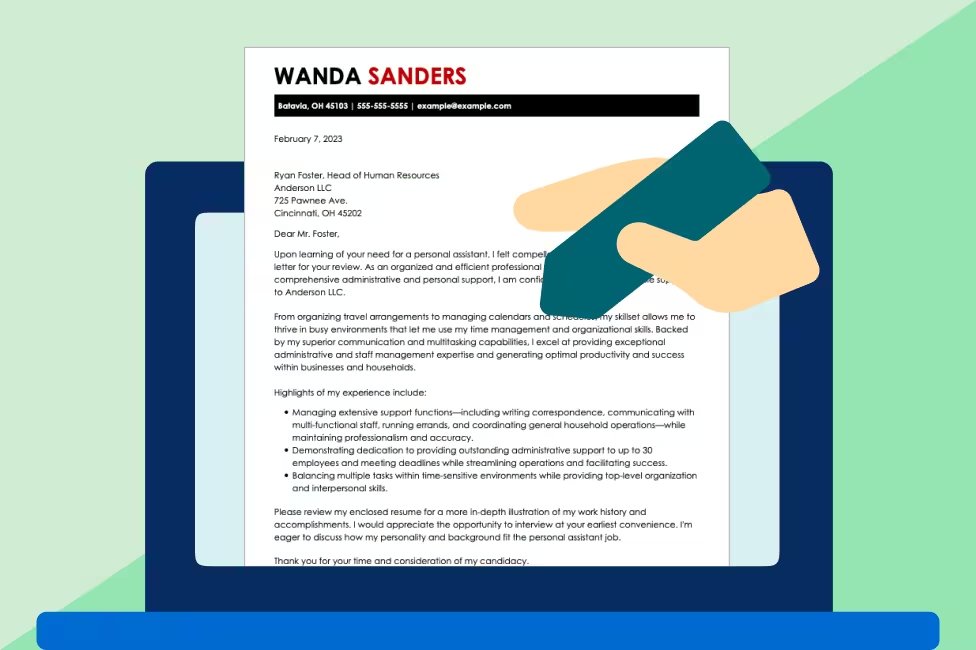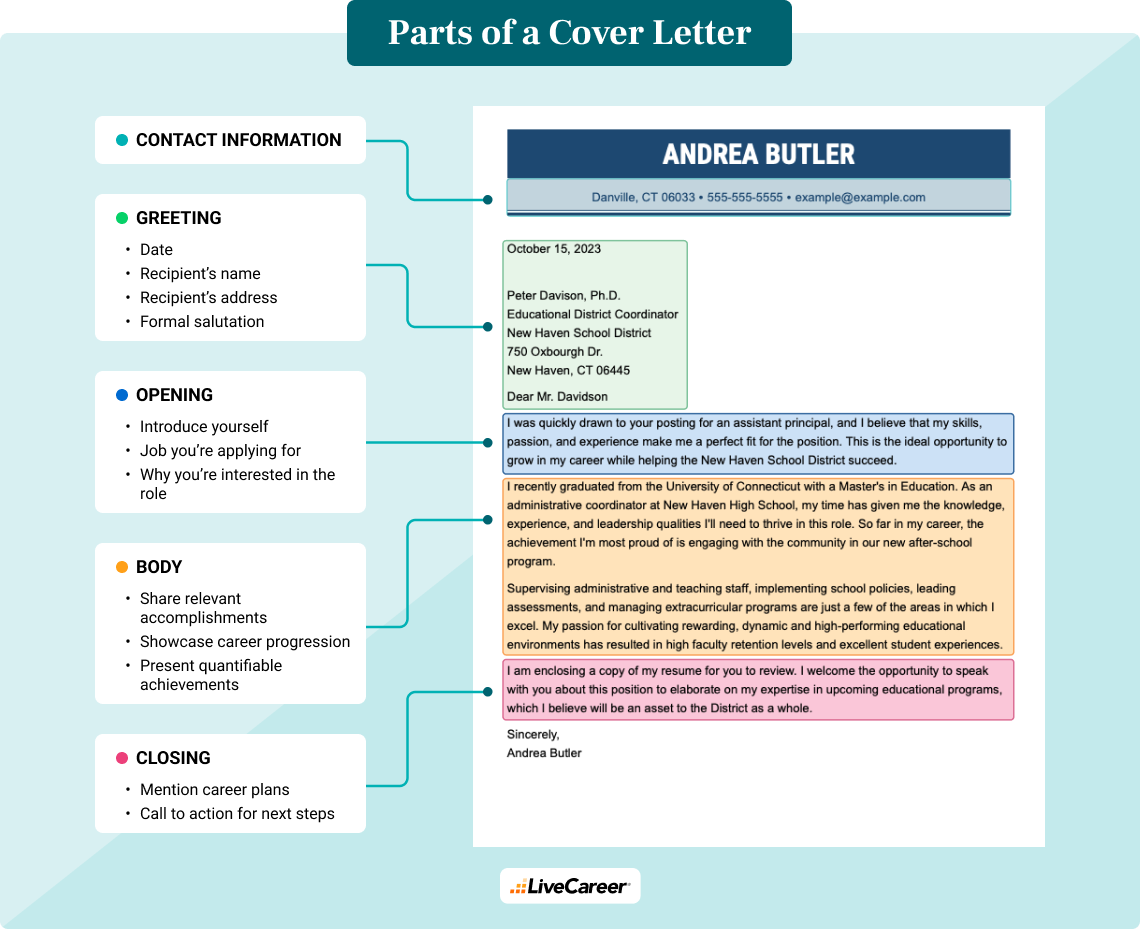How to Write a Cover Letter: Examples Guide for 2024
Learn how to write a cover letter that clinches the job. Check out our step-by-step cover letter writing guide, examples and tips to write a letter that impresses hiring managers.
See how to write a cover letter for a job, including:
Want to skip the reading and finish your cover letter in 15 minutes?
We also offer an incredible tool, our Cover Letter Builder! It automates the writing process into a series of easy-to-answer prompts.
What is a cover letter, and why is it important?
A cover letter is a one-page document sent alongside a resume or CV that summarizes your professional experience and explains why you’re an excellent fit for the job.
It consists of contact details, a greeting, three to four paragraphs and a formal signature.
Your cover letter should:
- Include two to three examples of your top achievements.
- Tell a story of your skill level and career path.
- Explain why you’re a good fit for the role and company.
- Include any relevant details you can’t fit in your resume or CV.
PRO TIP
A great cover letter can pique a hiring manager’s interest. 83% of recruiters will interview candidates with great cover letters! If you’re serious about a job, include one.
How to write a cover letter
Here, we’ll break down the process of how to write a cover letter for a resume in six easy steps.
STEP 1
Pick a cover letter template
Cover letter templates are a great tool to jump in and start writing! Templates save you time and effort because the formatting and design of your cover letter are already in place.
Find a template design you like, and just plug in your information!
Professional graphic designers create our cover letter templates to look sharp and modern. Best of all, they’re designed to pass applicant tracking systems (ATS), which most companies use to scan your cover letter for keywords.
STEP 2
Write a professional header
Your cover letter’s header should include:
- Your name
- Location (city and state)
- Phone number
- The date of when you plan to send the letter
- Name and job title of the hiring manager
- Name and address of the company you’re applying to
- Your current job title (optional)
- Your LinkedIn page (optional)
- Links to your professional social media accounts (optional)
STEP 3
Greet the hiring manager
Addressing the hiring manager by name is a great way to show professionalism and attention to detail.
Avoid addressing the recipient with “Dear Sir or Madam,” which is outdated and impersonal.
It’s always best to address them by their title and name. For example:
Good cover letter greeting examples:
“Dear hiring manager,”
“Dear [XYZ Company] team,”
“Dear Customer Acquisition Hiring Manager,”
Weak cover letter greeting examples:
“To whom it may concern,”
“Dear sir,”
“Dear madam,”
STEP 4
Write a compelling opening paragraph
Your opening paragraph should concisely state who you are and your interest in the position in no more than one or two sentences.
If a current employee at the company has referred you, you should mention it immediately in the opening paragraph. This way, the hiring manager will pay more attention to the accomplishments stated in your letter.
A few key elements that should appear in your opening paragraph are your:
- Profession/current job title.
- Desired position.
- Motivation for applying.
Compare these cover letter opening paragraph examples:
Good example of a cover letter opening paragraph
“After seven years working in marketing as a brand manager in multinational companies like P&G and Unilever, I want to use my negotiation and extensive knowledge of retail operations to expand your company’s market as a sales representative.”
Why this cover letter opening works:
In just one sentence, this applicant informs a potential employer of their years of experience, area of expertise, the role they wish to pursue and the skills to back up their career aspirations.
Weak example of a cover letter opening paragraph
“Hello. I am Lester Peterson. I hope you are doing well. I am writing to you because I want to apply to your company. I am a determined professional with all the qualities needed to excel in this role.”
Why this cover letter opening doesn’t work:
This opener sounds informal, and instead of showing examples of his qualifications, the applicant opts for empty statements that need more convincing detail.
STEP 5
Prove your value in the body paragraphs
Your cover letter’s body consists of one or two paragraphs where you offer more context to your career accomplishments.
Because the cover letter is a companion to your resume, you should mix up the language and descriptions you use. Expand instead of repeat!
Try to spin the details of your resume into a story. Narrate the challenges and opportunities during your career that led you to accomplish, for instance, an increase in sales, gaining a valuable client or leading a big project.
Check out these cover letter body paragraph examples for different approaches you could take depending on your unique situation:
Body paragraph example focused on career accomplishments
“In my previous teaching role, I carved out 10-minute slots in my senior class to do SAT prep testing, resulting in having the district’s highest SAT score average in English. My dedication to my student’s needs has always been my priority, and students responded with increased participation in the portion of the class allotted for the syllabus topics. After being named Teacher of the Year, I organized a continuing education and mentorship program for newly graduated teachers in the school district.”
Body paragraph example focused on skill set
“Throughout my career as an accountant, I have acquired skills in various areas of accounting and finance. In my first years, I worked in the public sector, developing budgets between $50,000 and $2 million and ensuring accounting records complied with federal and state regulations. Eventually, I moved to work in private equity firms. I gained firsthand experience in financial analysis in tech investments and monitoring funds’ investments, preparing all financial statements and presenting to investors and stakeholders.”
Body paragraph example focused on career goals
“After graduating from Columbia School of Social Work and volunteering in various non-profit organizations focused on at-risk youth and women’s shelters, I’m eager to put my skills to work as a counselor in the court system. My understanding of vulnerable children’s needs and challenges has inspired me to continue my career supporting children through their caregivers’ or their court proceedings.”
PRO TIP
If you find your body paragraph is becoming too long, use bullet points to break up blocks of text.
Body paragraph example with bullet points:
“In my current role as sales lead, I’ve attracted several local businesses in various industries and brought financial gains to our company and clients. Notable achievements in this capacity include:
- Adding 14 new accounts to our portfolio.
- Improving client retention rate by 47% over four years.
- Negotiating and renewing longer contracts with current clients, increasing net revenue by 11%.”
If you want your cover letter to impress a hiring manager, your body paragraph must be full of job-relevant skills and achievements — and written like a pro.
Our Cover Letter Builder will suggest over a dozen body paragraph examples you can choose from to wow employers.
You can edit these content suggestions with quantifiable achievements and keywords from the job ad to make your cover letter unforgettable.
STEP 6
Write a closing paragraph with a call to action.
Your closing statement should be concise and direct, leaving the reader excited to learn more about you.
Make sure your closer is:
- One or two sentences long.
- Direct about your eagerness to fill the role.
- Encouraging the reader to set up an interview.
- Polite and thankful.
Good example of a cover letter closer
“Let’s discuss my plans to contribute to XYZ Company’s mission to impact women professionals in their search for investment opportunities and financial education resources as Head of Marketing Operations. Thanks for your time in reading my application.”
Why this cover letter closing works:
This closer proves the candidate wants to have a serious discussion with a manager by getting specific. It offers both value and respect to the hiring manager.
Weak example of a cover letter closer
“All in all, you won’t likely find a better candidate than me. My qualifications and experience will knock it out of the park. Let me know when you can meet with me for an interview.”
Why this is a weak cover letter closer
Although supremely confident, this statement lacks substance, and the tone is off-putting. It’s demanding instead of polite and friendly.
STEP 7
Sign off and mention any enclosures
Your cover letter’s sign-off consists of two words at most. Plenty of signatures will make you sound like a pro, and others you should avoid.
Good cover letter sign-offs
Keep it formal and professional with these signature lines:
Sincerely,
Most sincerely,
Regards,
Best regards,
Kind regards,
Thank you,
Thank you for your consideration,
Respectfully,
Bad cover letter sign-offs
Avoid informal phrases you would use with friends:
Take care,
Take it easy,
Have a great day,
Love,
Yours,
Yours truly,
Cheers,
Best,
Warm wishes,
Affectionately,
Warmly,
XOXO
Emojis
Thanks,
Thx, or any other abbreviation
Enclosures
If you need to include additional documents beyond your resume –– like a portfolio of your work or letter of recommendation –– add a double space below your signature at the end of the cover letter. Then write “Enclosure:” for one document; “Enclosures:” for two or more documents. Below this, list each enclosure you are including.
Enclosures example:
Sincerely,
Tom Smith
Enclosures:
- Portfolio
- Letter of recommendation
Key takeaways
To recap the main points of how to write a good cover letter, keep these tips in mind:
- Write a fresh, custom cover letter for every job you apply to.
- Keep it to three to four paragraphs under one page.
- Use your cover letter to expand on details in your resume and tell a story.
- Ensure your document is free of errors.
Since your cover letter matters as much as your resume, you want to take this seriously! That’s why you should consider using our best tool for the job, the Cover Letter Builder.
The builder will suggest prewritten text tailored to the job you’re applying for. You can select it and customize it in your cover letter. Our career experts wrote these phrases to ensure you sound professional and capable.
Best of all, since the builder automates the process, you can complete your letter in just a few minutes!
Cover letter writing FAQ
How long should a cover letter be?
A cover letter should be 250-400 words and fit in a single page. It should consist of three to four paragraphs.
Your cover letter should not exceed these limits, as it may hint that you don’t value the hiring manager’s time.
Can I write a cover letter with no manager’s name?
Finding the hiring manager’s name in a cover letter is worth the effort because it shows your attention to detail and your seriousness about the role.
If you can’t find a name, it’s acceptable to use “Dear Hiring Manager,” “Dear Hiring Team” or “Dear [Department Name] Manager.”
Should you send a cover letter by email?
Yes, nowadays, more cover letters are sent by email than via the postal service.
If you’re using an online job application portal, there may be a field where you can upload your cover letter as a Word Doc or PDF file instead of emailing it.
Is a cover letter necessary?
Cover letters are recommended but not always necessary. However, a well-written cover letter boosts your job chances by showcasing your personality and communication skills!
Only skip sending one if the job post says not to or there’s no place in the online application portal to attach one.
What are the goals of a cover letter?
The goals of a cover letter are to give an introduction about yourself, explain why you want the role and feel like you’re a great fit.
Hopefully, doing so will help you connect with the employer and increase the likelihood that they’ll give you a job!
What does an employer look for in a cover letter?
Employers are looking for two main things in cover letters:
- That you have the skills and experience necessary to do the job.
- A little insight into your personality and what motivates you to apply for this role.
What do I write in a cover letter?
Your cover letter should focus on your motivation for applying for the role and the reason(s) why you feel like you’re a good fit.
If you can tell a story that illustrates you have the skills the employer seeks, even better!
How do I write a cover letter for an internship?
When writing a cover letter for an internship, you should:
- Cite the internship position you want.
- Mention the required skills from the internship advertisement or post.
- List relevant coursework or projects that show you’re capable.
- Explain your motivations and career aspirations.
- Emphasize what the company can gain from your unique abilities.
How do I format a cover letter?
Cover letters follow a standard business letter format. Include the following sections to format a cover letter accurately:
- Your contact information and the recipient’s information.
- A greeting for the hiring manager.
- An opening paragraph that mentions the job you want and your top reasons for believing you’re a good fit.
- One or two body paragraphs (you can use bullet points) showcasing your qualifications.
- Closing statement with a request for an interview.
- A signoff like “Best regards” or “Sincerely.”
- Your name and signature.
What is the best cover letter template?
The best cover letter template is the one that provides you with a visually attractive but practical design.
Our builder features 25+ expert-approved templates that are fully customizable!
You can change the fonts and colors, adjust margin size and even include additional sections to discuss availability, relocation and employment gaps.
What are some cover letter mistakes?
Double-check that your document avoids these common cover letter mistakes:
- Avoid including paragraphs that are too long. You should always have a paragraph that is at most five sentences. It’s too wordy! Instead, consider bullet points in your body paragraph to break down your text into easy bite-sized statements.
- Don’t write the exact phrases you have on your resume. In your cover letter, you need to expand on the details you list in your resume, not repeat them. Try to bring the details of your resume to life by turning them into a story.
- Remember to include numbers to illustrate your achievements. Numbers capture attention. Using dollar amounts, numbers, or percentages gives verifiable proof of your success, and employers will notice!
- Never send your cover letter using your current company’s email. Recruiters will perceive it poorly, and employers may monitor company emails. Use a personal, professional email instead.
- Don’t discuss salary. Only mention money if explicitly asked to state your desired salary by the job post. Never include information about your current salary. Some states have made it illegal for recruiters and hiring managers to ask about salary history.
- Don’t make a generic cover letter for all your job applications. Each job you apply to deserves a fresh, tailored cover letter. Pay attention to the job post or ad details to better understand what the employer wants to hear!
How we reviewed this article
Over the past 15 years, we’ve helped more than 10 million job seekers build stronger cover letters, discover their career paths, interview confidently and boost their chances of finding the right job faster. Review our Editorial Policy to learn more about our process.
Related content
As seen in*
*The names and logos of the companies referred to in this page are all trademarks of their respective holders. Unless specifically stated otherwise, such references are not intended to imply any affiliation or association with LiveCareer.







